
Menu
I will help you train your horse in a diverse, individual and horse-friendly (horsological) way, through intensive training days (“clinics”), coaching, and lessons for you or schooling your horse for you.
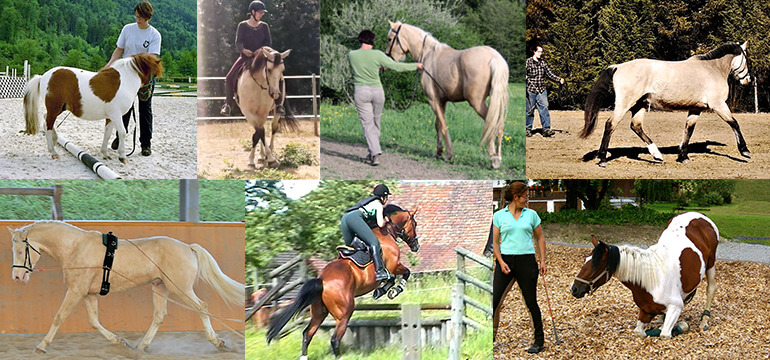

I will help you train your horse in a diverse, individual and horse-friendly (horsological) way, through intensive training days (“clinics”), coaching, and lessons for you or schooling your horse for you.

My philosophy is that a horse should be trained as versatile and diverse as possible. This ensures variety, and is the base for a balanced, healthy training. Note: the more your horse gets to know during its training, the safer and more relaxed it will become.
The combination of ground work, lunging with a single or double lunge, as well as dressage in-hand and classic dressage successively teaches your (young) horse the 101 of the reliable riding horse and leisure companion. Circus lessons (tricks), pole work or little jumps in both the arena and on the trails enrich the program and provide for even more variety.
In lessons individually tailored to your horse’s needs, it will be learning
• groundwork
• lunging (single and double lunge)
• dressage in-hand
• and moving in all gaits under its rider in a healthy and relaxed posture while being ridden with light and subtle aids.
Learn what you want to teach your horse or what your horse is learning. Or simply learn more to improve your own skills and abilities.
Book Seated-Lunge lessons for an intensive work-out of your smaller or bigger challenges like stiff hips, unsteady hands or simply for improving your independent seat or learning to ride when you’re just starting riding.
Spend your holidays with us at Paradise Farm in McLeese Lake BC, Canada and learn with either my horses the topics you would like to teach your horse or bring your horse and benefit from intensive training in a picturesque setting to further improve your and your horse’s skills.
Join me for Intensive Training Days or for Lessons. Let me coach you during starting your young horse.
Intensive Training Days are a 2- or 3-day event with 3 to 4 (semi-)private lessons per day and ample time to discuss the theory of certain movements, aids or training methods or just to get your questions answered.
Lessons can be booked at any time I am around and available. I usually give private lessons, but if you prefer, semi-private lessons are fine with me too. If travelling to McLeese Lake on a regular basis is not feasable, Online-lessons might be the solution for you. If we can arrange a few lessons gathering riders on the same day in Williams Lake or Quesnel, I would also travel to come teach you locally. At the moment I travel to Dragon Place Farm in Quesnel every two weeks. Please contact me if you want to join me there.
Training: 16 weeks of intensive coaching. I will accompany you and your young horse through my horse-friendly and horsological basic training to become a confident and safe riding horse.
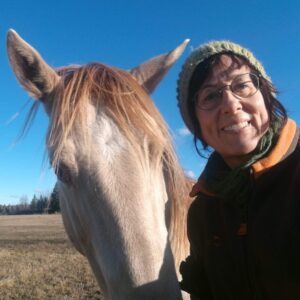
Riding instructor, Horse trainer, Course author, Horse breeder of colored Warmblood horses
For as long as I can remember, I have been fascinated by horses. As a child, I read every available horse book. My own horse book collection is well over 100 books (about horses in general, behaviour, training and medicine).
At the age of 14, I became one of 9 pony girls with the owner of 10 ponies of different breeds, who went regularly to the barn to clean, ride and care for “their” pony, usually 2-3 times a week. My pony was an Icelandic yearling. As Icelandic horses were already then lucky to enjoy 4 to 5 years of unridden time, I was only allowed to literally run around with him for 3½ years while all other girls were happily riding their pony… Unfortunately, at the age of 5, he had a fatal accident on the other side of the pasture fence and we couldn’t get much further than all the basic gaits under the saddle. Nevertheless, he laid the foundation for my equine way of thinking and my enourmous amount of interest in training horses.
Years of riding other people’s Warmblood horses followed before Renja came into my care: Renja was a Swiss Warmblood mare, then 8 years old and from official side declared unridable. Which I first didn’t know and then ignored. Above all, Renja taught me that horses can and certainly should be trained differently and that the traditional system (undeniably quite useful for military purposes) does not fit every horse. So, in the course of 10 years, she became a good riding and carriage horse.
1995, my first own horse: Uccello! I owe him my greatest achievements in my personal development on the way to becoming a horse trainer. He came with me to the trainer courses, I learned everything about stallions and their training from him, we went to clinics and shows, and he led me twice to near-death experiences. To this day, he is one of my most versatile horses and always eager to please.
Since 2002 I am a certified riding instructor and horse trainer. I love to teach other horse people and / or their four-legged friends. In addition to all my horses, I have trained and ridden many horses of other owners. In all those years I developed my proven method, which is based on horse-friendly and close-to-nature husbandry, mutual trust and versatile training.
From 2002, my herd of horses continuously grew by 4 more stallions, including Neon, my pedigree stallion, as well as 5 mares. Between 2005 and 2016 I bred over 20 colored horses, especially deluted colors (buckskins, palominos, cremellos). My horses always lived at least in an open-air stable setting, no box stalls, and always in groups. They taught me everything about stallions, mares and foals, breeding, training and raising horses. In 2020 Champagne Request, an Appaloosa stallion, joined us and maybe another colored and dotted baby horse will be born in the next few years.
Since autumn 2013, I have been able to offer my horses the natural life I have always wanted for them. We moved from Europe to Canada to live on over 70 ha of diverse land with pastures, forest, streams and hills, where they can do what horses do and live a healthy and happy life.
I myself ride mainly in the English riding style: classical dressage, jumping, eventing, lots of trail riding. Every now and then I took a lesson in the Western saddle or participated in reining or trail shows. I’m driving carriages with one horse or a team of two, pull trees or groom pastures with the horses.
Education and Trainings:
• Specialist conferences on the subject of feeding (working group for horses, Dr. Arno Lindner), behavior and behavioral disorders in horses (Swiss Association for Equine Medicine), horse keeping (University of Freiburg, Germany), animal welfare-friendly horse keeping (STS, Olten)
• Equine first-aid (Prof. Von Salis)
• Circus Lessons (Franco Gorgi)
Horse trainer and Riding instructor Training and Diplomas (Trainer’s names):
• Mascot Practitioner Riding (Doris Süess, Andrea Schmitz)
• Mascot Practitioner Seated Lunge (Doris Süess)
• Mascot Practitioner Ground Work (Doris Süess)
• Mascot Practitioner Bodywork (Doris Süess, Susan W. Tenney CMT, Elisabeth Kull, Jonathan Cohn, CMT). Mascot is now called Sintakt, the courses and trainings are eduQua and ISO certified
• Trainer C Riding German FN (Markus Lämmle, Stockfelderhof)
Trainers:
• Show Jumping (Niklaus Schurtenberger, Willi Melliger, Doris Süess, Claus-Henning Horner, Hannes Wendt, Walther Thomann, Markus Lämmle)
• Classical dressage (Doris Süess, Andrea Schmitz, Elke Potucek, Henrique Maya, Michael Putz, Silvia Rall, Markus Scheibenpflug)
• Eventing (Doris Süess, Sandra Scacchi)
• Driving (Stallion Depot Avenches)
4 semesters of Veterinary Medicine Studies
1 year of Military Service (Truck Driver)
4 years of Training as a Horse trainer and Riding instructor
1 year Commercial School
8+ years Police officer
2 years Riding instructor in Austria
7+ years Boarding Kennel Tannenboden, Switzerland (3 years training for licensed pet keeper, working in the management and as a veterinary assistant)
6 years “Pferdehof zum Wasserfall” (Breading and raising of colored Warmblood horses, Training of riders and horses) in southern Germany
Moving to Canada in 2013
After 3 more years of breeding colored horses and 2 years as a veterinary assistant, I have been focusing on training horses and riders and of course training my own animals.
The more versatile a horse is trained, the more relaxed, safe and healthy it is. Holistic Horse Training offers you and your horse lessons and Intensive Training Days on the following topics:


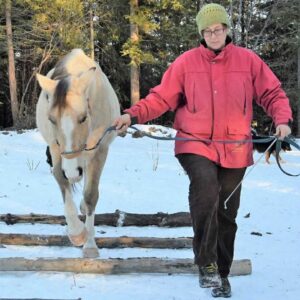
Groundwork forms the basis of all work with the horse. It is varied and instructive for the horse, helpful and attractive for us horse people. Groundwork is the first step in training a horse to becoming a reliable partner.
Groundwork has a gymnasticating, concentration-promoting effect on the horse and teaches it to use its feet in a coordinated manner. Young horses learn to react to the subtle signals of us humans. Thanks to the training with a wide variety of materials and structures, the horse learns a fundamental cool-headedness towards unknown things and situations. Groundwork also helps to solve problems of dominance and to define and consolidate the hierarchy with the rider as the highest in rank, which is essential when dealing with horses.
You learn to respond to your horse, to recognize his facial and body expressions, to interpret and to draw conclusions from them. By observing the horse intensively, you will learn to act or react in the right way at the right moment. As a result, the human-horse relationship gains in subtlety and emotional attachment to each other.
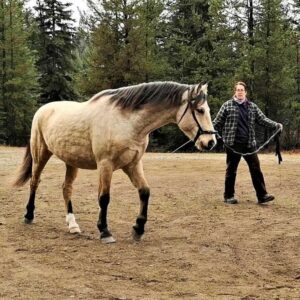
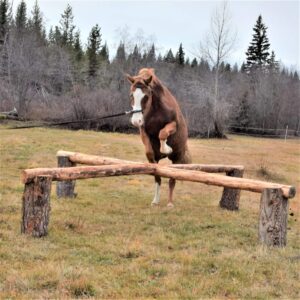
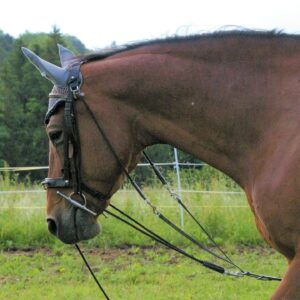
Working on the lunge is more than just making a horse run in circles. Lunging is diverse, efficient and fun for horse and human!
Exercise, train or correct your horse with just a well-fitting halter or cavesson bridle and lunge. Targeted and temporary use of auxiliary reins can assist the horse to learn a healthier posture.
Lunging includes many different facets and is – done properly – part of good horse training. Lunging of
• Various figures (circles, voltes, straight lines, lead changes, serpentines etc.)
• Reducing and enlarging circles
• Backing up
• Changes of gait or pace
• Work on and over obstacles (poles, cavaletti, tarpaulins, water, ditches and jumps…)
the horse is being trained for more flexibility and elasticity, it builds up muscles and stamina, learns to find its balance without the rider’s weight, improves its dexterity, agility and coordination and learns to trust and pay attention to fine signals of the lunging person.
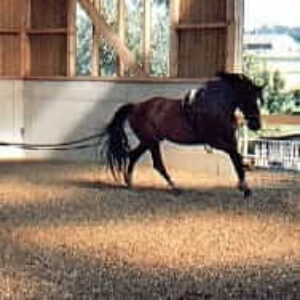

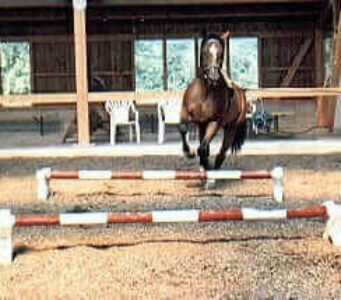
The work on the double lunge is for the young horse a preparation for riding and driving – it gets to know the rein aids – and for all horses an additional kind of work for gymnastication and as a preliminary exercise for the work on the long rein.
As with the work on the single lunge, you get to lunge diverse figures and changes on the double lunge too, even lunging over poles and cavaletti or practicing jumping over obstacles and ditches is possible.
The handling of the double lunge requires a little coordination skills from the lunging person but it is quite learnable and no rocket science!
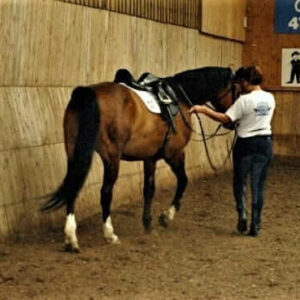

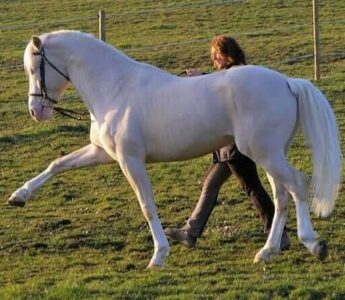
The horse gets specifically gymnasticated, trained and brought forward from the ground without the rider’s weight.
This work is also ideally suited for horses that are not, not anymore or not yet to be ridden. You can teach your horse all lessons such as transitions, pace differences, lateral movements, piaffe, Spanish step, etc.
While walking next to the horse you improve your stamina and coordination skills, train your eye for the correctness of the exercises and learn to give precise aids.



Circus lessons are a welcome variation and great way to gymnasticate your horse! They help to solve hierarchy problems with our horse and are a proven way to raise a young horse’s self-esteem.
Starting from the basic exercise “Stand” and “lift hoof on a slight tap with the crop”, the horse learns “compliment”, “kneeling”, “lie down” and “sit”. The “Spanish step” and climbing a pedestal are also part of Circus lessons.
If you have a dog that is eager to learn and gets along with the horse, you can rehearse exercises with both of them.

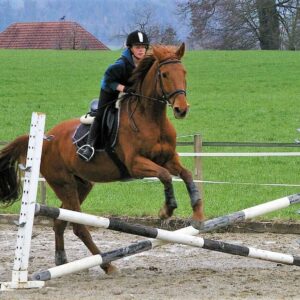

The base of my equestrian work is classical dressage. It doesn’t matter to me whether the horse is carrying a Western, dressage, Spanish, Australian or no saddle at all. My method and goal is a relaxed, forward-going, happily cooperating and healthy horse.
In addition, I believe that a certain amount of dressage work is beneficial for every horse to maintain or improve its health. This does not require an expensive riding arena; a simple dirt road or a flat piece of pasture do the trick to achieve the different steps on the horse’s training scale (Rhythm, Suppleness/Relaxation, Contact, Impulsion/Schwung, Straightness/Alignment, Throughness, development of Carrying Capacity, Collection and Elevation). In my experience, young horses find it easier to work on the first four steps in the field rather than in an arena and ideally together with other horses so they are not stressed about being alone. That’s why I start all horses on the trails. Foals and their mothers are coming with other horses on trail rides and before a young horse is ridden itself it will be again out with an experienced horse as an in-hand horse. This way they get used to the environment, learn to pay attention to the trails, and learn my vocal signals for the different gaits and for stopping, which they will later hear again when lunging.
A healthy horse actually knows all the movements. For example, playing young stallions already show the entire spectrum of dressage, including pirouettes, flying lead changes, piaffes. The difficulty for us riders is to make ourselves understood by the horse and to ask for the desired movements or manoeuvres. Riding is translating our wishes into a sign language the horse can understand. As a result, the actual task of horse training is to teach the horse this sign language (rein, leg, weight and vocal aids) and it is important to avoid confusion by not communicating clearly, by not having a strict plan we stick to or by contradicting ourselves with the signs.
Work units / lessons consist of three parts: warm-up, work, cool-down. During the work phase I give frequent, short breaks in walk on the loose rein as a reward, in which the horse can stretch and relax. Warming up and cooling down is not meaningless trotting in circles. It can be a gymnasticating shoulder-in, a few transitions to halt, some backing up or a few minutes of in-hand work.
Even though I mainly teach classical dressage, I like to incorporate work over poles or small jumps. They help the horse to focus (on the ground) and train its flexibility, reaction and responsiveness.
I offer tailor-made Intensive Training Days, lessons and farm stays for horse owners and riders or people who want to become one. They will improve your skills or prepare you for a life with a horse.



then seated lunge lessons are ideal for you. During the seated lunge lesson the rider can work intensively on herself, without having to worry about “guiding” the horse. In this way, the horse’s movements, footsteps and beat can be perceived and recorded and your own movements can be adapted, improved and refined. A correct, deep seat is important.
The rider feels and improves his seat in all three gaits and refines the aids of legs, weight and upper body, as well as sensitive rein guidance. I emphasize the great importance of the inner attitude and enrich my lessons with visualizations and gymnastic exercises that improve body awareness and posture.
By incorporating various exercises, some according to Feldenkrais, the good dressage seat is felt, perceived and implemented in a variety of ways in all gaits. I also give advice on compensatory sports or stretching exercises that help the rider to improve her seat or posture or relieve muscle tension.
With the help of targeted exercises, personal challenges such as restless hands or legs, difficulty sticking to the saddle in trot etc. can be resolved thanks to the varied design of the lessons and the use of a variety of exercise equipment.
If you are new to jumping obstacles you can also be introduced to jumping on the lunge.
If you feel a little rusty or generally value strong muscles, you will like the many different gymnastic exercises with which I usually begin a seated lunge lesson. The aim is to strengthen the trunk muscles, especially the abdomen and back, as well as strengthening the legs and buttocks.
Stretching exercises and special exercises for the upper body, shoulders and arms complete the “comprehensive fitness program” ;-). At the same time, you train your sense of balance and gain trust in your seat on a horse. The movements of the horse provide additional excitement: inconspicuous, simple exercises on the ground become more difficult on a horse and make the lessons efficient and not seldom also very fun.
After this warm-up phase, we’ll work on your personal topic or the basics needed for riding a horse. Finally, one or two relaxation exercises will form the conclusion of the seated lunge lesson.
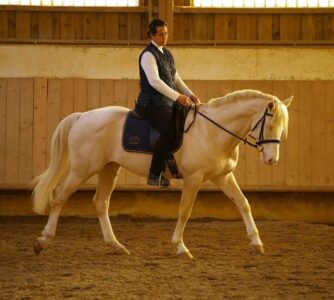

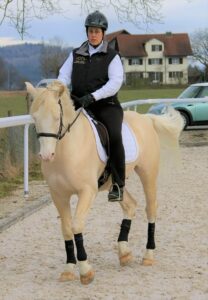
Individually tailored to rider and horse and their level of training, I teach the principles of classical dressage.
Is your goal:
I can help you make your dreams come true with specific exercises, sequences of exercises and individual training approaches.
Particular attention is to be paid to the good seat of the rider. The balanced, sensitive seat, independent of the reins, guarantees the rider’s relaxation, ability to move every part of his body independently and thus riding with fine and light aids.
With many different exercises we will achieve an increased gymnastication of the horse, so it strengthens its hindquarters which then can take on more weight. The development of lessons with higher collection then no longer causes much difficulties for horse and rider.
In my riding lessons, I pay great importance to the correct and friendly handling of the horse. It should be worked consistently, but in a fair way – with the lightest possible aids – to benefit from the lessons. It learns to be guided by mainly weight and leg aids, as well as your direction of focus and the rider’s inner attitude. With varied, efficient exercise sequences, with lateral movements and transitions I will help you and your horse to become a unity of man and horse.
The warm-up phase plays an important part when working with the horse. The horse is prepared and warmed up through: loosening lateral movements, walk and trot with tempi variations and transitions. The warm-up doesn’t need to take long, 5 to 10 minutes is enough.
If preferred, the horse can also be warmed-up from the ground through dressage in hand. This is particularly recommended in winter, as it warms up also the rider’s cold limbs.
In the working phase we deal with horse-specific or rider-horse-specific concerns, such as correct contact on the aids, flexion and bending, straightness, throughness, transitions, lateral movements, lead changes etc.
The cool-down phase is also important at the end of the lesson. The last part of the lesson is characterized by quiet exercises in walk and on a long rein, also to check the previous work. But there is also the opportunity to do something for the fitness and mobility of the rider, e.g. some gymnastics on the horse.
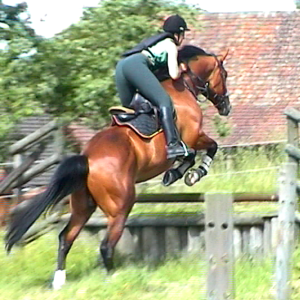

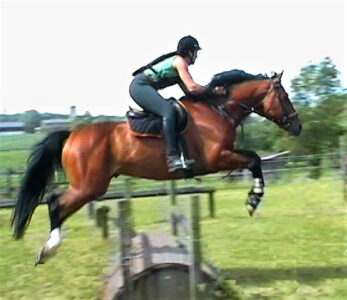
The Chiron jumping style is also very suitable for jumping beginners or anxious show jumpers. The rider learns a balanced, light but stable seat, the horse learns to think for itself and to stretch. After a short time both of you have a lot of fun jumping all kinds of obstacles.
The Chiron jumping style – based on the ideas of the Italian Frederico Caprilli († 1907) – was further developed by the German Rolf Becher. Caprilli promoted a style in which the horse was given the greatest possible freedom, the “school of non-interference”: a light connection from the bridle to the soft and responsive rider’s hand and a balanced seat with an angled body and a foundation-like hold in the stirrups, which enables the rider to follow in elastic balance with the movements of the horse.
With the Chiron method, the horse is trained to be independent, its self-confidence is strengthened and its character is positively influenced. The most important point is the trust between horse and rider.
The basis of the correct, horse-friendly jumping seat is the stable foundation formed by the rider’s knee, lower leg and foot and the posture of his upper body. By lowering the shoulders, the hips shift backwards, creating a weight triangle of shoulders, hips and foundation. Shoulder, knee and stirrup are in a vertical line one above the other.
The stirrup lies under the widest part of the foot, creating the feeling of standing on the ground. The hands follow the forward-downward movement of the horse’s neck and allow the horse to basculate.
We start with jumping seat- and rhythm exercises, which are followed by exercises in an alley, riding correct turns, working over poles, flying changes of lead, working over verticals, spreads, and double and triple combinations, and finally jumping natural obstacles.
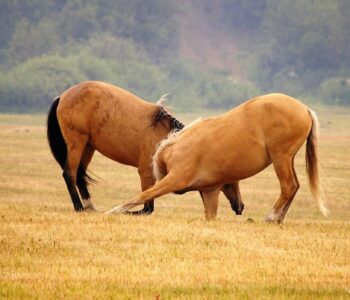
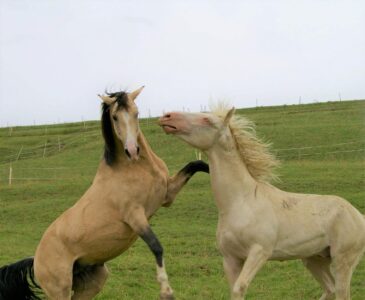

When dealing with the horse, it is particularly important to know what the horse wants to express through its body language. It is also important to know why, when, how a horse reacts or acts.
The horse expresses itself primarily with its body language and very rarely with its voice.
It takes a lot of time to get to know how horses communicate with each other. We have to observe how the animals behave, how they communicate with their fellows and how they react to such communication from others.
The following questions need to be answered:
Behavioural studies mean observing, describing and interpreting. I will help you to understand horses properly, giving you inputs and explain the most important behavioural patterns.
Our 13 horses live in two herds and can move freely in different areas of our property, each with at least 12 hectares of varied land. Thus there is an infinite amount of behaviour to observe and study.
We have a 35 x 55 m natural Riding arena with a fenced 20 x 40 m ring.
There is ample room to manoeuvre with truck and trailers and if needed we can provide a round pen for our guests.
A few years ago I started building a “Springgarten” and am adding jumps each year. The “Springgarten” is a fenced part with solid jumps you might find in the cross country part of eventing shows. The jumps are not higher than 80 cm, but some look quite impressive. If possible, I built them in a way they fall apart in case a horse doesn’t jump them properly (safety first).
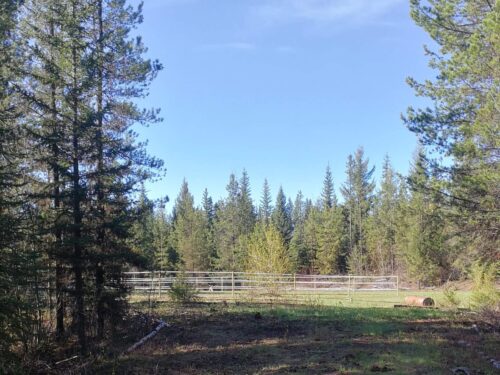

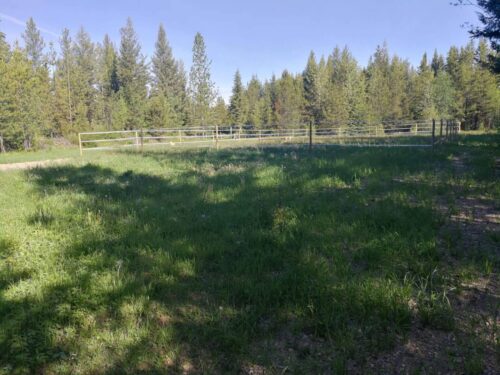

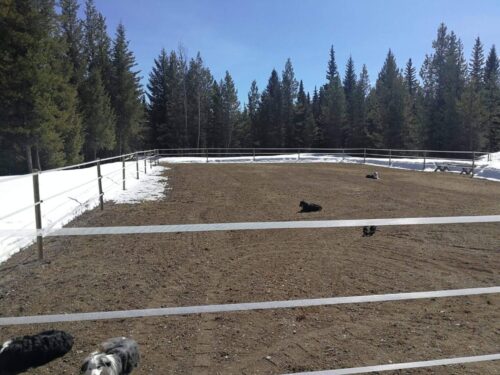
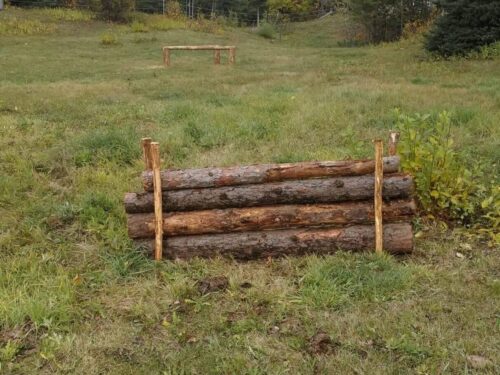
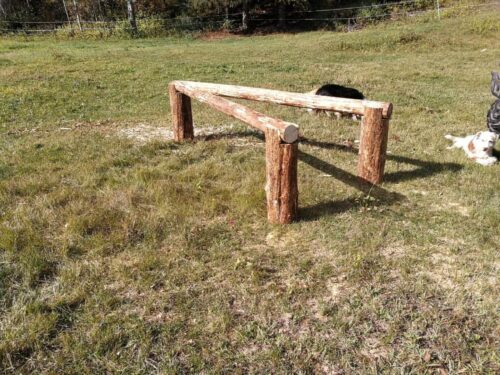


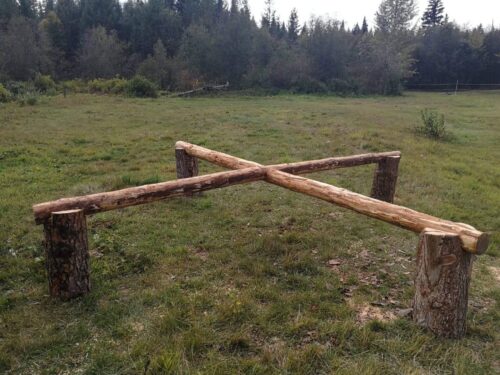


Come see me with your horse for private lessons. We will discuss your goals and challenges at the beginning of every lesson and adapt the lesson’s content accordingly. Private lessons can be any topic you want. If helpful I will suggest another way to achieve your goal, either when discussing it or during the lesson.
The duration is about 50 minutes, but it might be a little shorter or longer depending on your horse and how much we achieved during the lesson. If your horse is a quick learner, endless repetitions will be counter-productive. Horses can concentrate for about 10 minutes at once, so adding short brakes a few times during a lesson are required for better success. A horse also understands a break as a reward, which means that terminating a lesson after good work is beneficial for fast progress.
There is also the possibility to take a lesson on one of my horses. This might be helpful when you are about to learn something new to your horse and yourself, so you can learn first how a certain manoeuvre feels when the horse is doing it right.
And finally, if you are just starting to ride, then private lessons are the best way to learn. The first about ten lessons are seated lunge lessons. I lunge a quiet, obedient horse of mine and teach you a good, balanced and independent seat through many different exercises. Once you feel safe and stable in all three gates on the lunge, we proceed to adding reins and having you control the horse yourself.
Of course, if you have your own horse and would like a seated lunge lesson on your horse, then we can do that too. It just has to know lunging and react promptly to commands, especially the ones for going slower or stopping.
Seated lunge lessons are about 30 minutes long.
Book your lesson via the contact form or send me an email.
Have a look at the Intensive Training Days Calendar!
I’m giving regularly Intensive Training Days at our farm and announce their topics in the Intensive Training Days Calendar.
The Intensive Training Days will be held with a minimum of two participants. Spectators are welcome, but they don’t count as participant. As with the Custom Intensive Training Days, participating horse-human pairs will be working several times a day.
Please book your spot via the contact form.
If you can put together a group of at least 3 people, I’m happy to give full-day Intensive Training Days. Every day of the Intensive Training Days (duration approx. 6 – 8 hours) the actively participating horse-human pair enjoys theory and several sequences of practical work. Viewers are welcome to attend the Intensive Training Days (please bring a seat).
If you prefer or need be, you can rent one of my horses to take part in the Intensive Training Days.
Depending on the Intensive Training Days‘ content, a topic can be spread over several days, even non-consecutive days. This is particularly useful for circus lessons or (double) lunge, as you can practice at home between the training days.
Two different topics can also be combined in one day. Good combinations are, for example, lunging and circus lessons or classical dressage and dressage in hand.
Depending on the topic and the number of participants, each rider and horse pair works several times a day. A good basic fitness and stamina is therefore required for both.
When you’re not working yourself, you will learn a lot from watching and listening while the other participants work.
Please contact me or send an email to discuss a program tailored to your ideas and needs!
Some horse owners are unable to travel to me with their horse. Based on these considerations, I decided offering to travel to you for lessons and clinics at your place.
Lessons:
I’m happy to come to your stable or to an arena organized by you on a weekly basis or according to your needs and teach you and your horse in private lessons.
If there are other riders who would join for private lessons, the costs for my travelling could be shared.
Intensive Training Days:
If you can put together a group of at least 3 people, have a suitable arena or a piece of flat, fenced pasture available and are interested in being taught by me, nothing stands in the way of Intensive Training Days of your topic-choice and at your place.
Please contact me to put together a program that is individually tailored to your ideas and needs!
Starting (Coaching):
Join me with your horse for 16 weeks of basic training and starting your horse.
Your horse will get a solid foundational training for becoming a safe, trusting, healthy and happy riding horse. Starting with groundwork, then lunging with single and double lunge, dressage in-hand and finally riding are the topics we will teach it. You will be the active part in the training, so you learn what your horse learns and also how to work with your horse. I will instruct you to train your horse. Coaching is ideal for you if you are a good rider and want to start your horse yourself, but need some guidance.
Training:
Does your horse need a tune or touch up? I’m helping you with that too. Whether you want it to become more safe on trails, better responding to your aids, fit for the next season or more advanced in the dressage ring, a stay of at least one month will improve your horse’s skills, flexibility and stamina. Included in the fee is one weekly lesson for you with your horse.
Please contact me for available time slots.
Of course, guests with their own horses are also welcome at Paradise Farm!
We have a pen for your horse and a few spots to set up your camper or tent for an overnight- or a several days-stay.
The price per horse per night including hay and water is $15.
If you wish, individual training lessons can be arranged.
Please send an email or contact me via the contact form to reserve your dates.
In addition to Intensive Training Days and lessons already presented, I am also happy to give seminars/webinars of several hours to one day duration about general horse knowledge or horse-specific topics:
• Species-appropriate horse husbandry
• Horse feeding
• Saddle and bridle
• Bits and bitless bridles
• Basic horse care
• Basic training of foals and weanlings
• Training of young horses
• Health prophylaxis
• Colors and color breeding of horses
• Handling stallions
• Training and training structure • Species-appropriate horse husbandry
• Horse feeding
• Saddle and bridle
• Bits and bitless bridles
• Basic horse care
• Basic training of foals and weanlings
• Training of young horses
• Health prophylaxis
• Colors and color breeding of horses
• Handling stallions
• Training and training structure
Please contact me to inquire about individually tailored arrangements and prices.
For everyone who would like to be taught by me but who lives too far away, I’m offering online lessons.
Let somebody video you while working with your horse, send me the link to your previously uploaded (to YouTube or Vimeo etc.) video and I will give you tips and advice on how to continue your training with your horse.
Please read up on Online Lessons, how exactly the process is.
PO Box 125, McLeese Lake BC
V0L1P0
Canada
© 2015 – 2024 Holistic Horse Training
all rights reserved
| Cookie | Duration | Description |
|---|---|---|
| cookielawinfo-checkbox-analytics | 11 months | This cookie is set by GDPR Cookie Consent plugin. The cookie is used to store the user consent for the cookies in the category "Analytics". |
| cookielawinfo-checkbox-functional | 11 months | The cookie is set by GDPR cookie consent to record the user consent for the cookies in the category "Functional". |
| cookielawinfo-checkbox-necessary | 11 months | This cookie is set by GDPR Cookie Consent plugin. The cookies is used to store the user consent for the cookies in the category "Necessary". |
| cookielawinfo-checkbox-others | 11 months | This cookie is set by GDPR Cookie Consent plugin. The cookie is used to store the user consent for the cookies in the category "Other. |
| cookielawinfo-checkbox-performance | 11 months | This cookie is set by GDPR Cookie Consent plugin. The cookie is used to store the user consent for the cookies in the category "Performance". |
| viewed_cookie_policy | 11 months | The cookie is set by the GDPR Cookie Consent plugin and is used to store whether or not user has consented to the use of cookies. It does not store any personal data. |
Send your Horse to a Working Vacation
AVAILABLE FROM MAY 2024
Location:
Holistic Horse Training at Paradise Farm, McLeese Lake BC
Trainer:
Pascale Kull, IGEQ Level 1 Trainer, Mascot Practitioner Riding, Seated Lunge, Groundwork and Bodywork
Costs:
$250 per week (minimum stay 4 weeks)
Requirements:
Horse ≥ 5 years old, Owner/Rider needs a HCBC membership